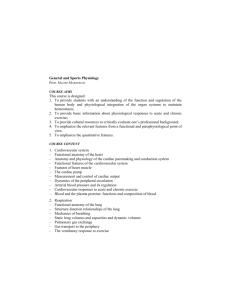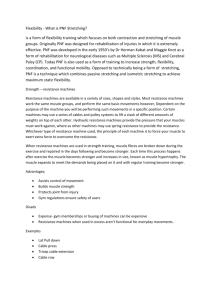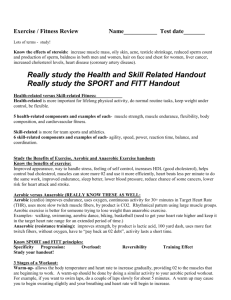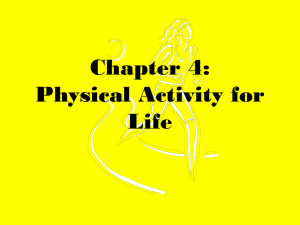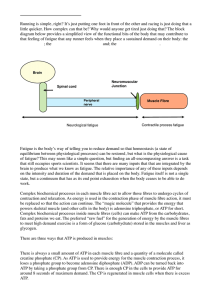File - Miss Firmager
advertisement
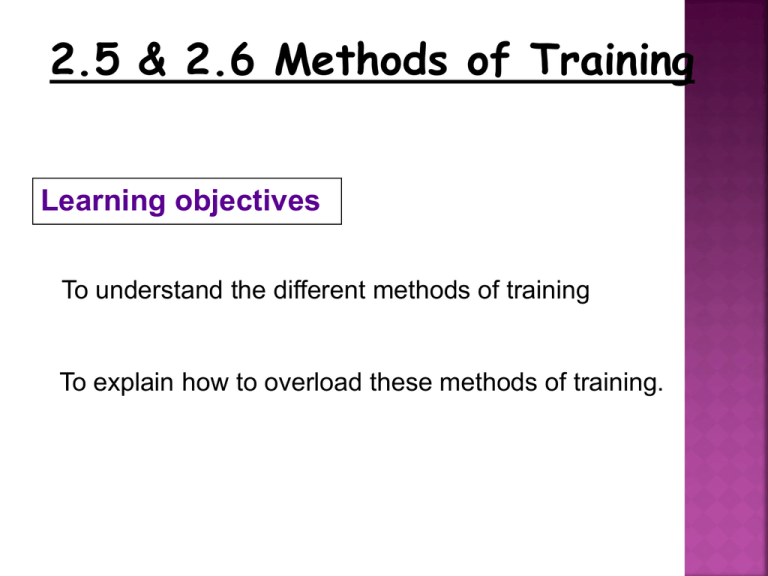
2.5 & 2.6 Methods of Training Learning objectives To understand the different methods of training To explain how to overload these methods of training. CIRCUIT TRAINING FARTLEK TRAINING STRENGTH TRAINING METHODS OF TRAINING CONTINUOUS TRAINING INTERVAL TRAINING PLYOMETRIC •CONTINUOUS training involves LONG, SLOW, DISTANCE exercise. •It is performed at a CONSTANT RATE WITHOUT REST. •Training at first should be at 60% of maximum heart rate, increasing to 75-80% of maximum heart rate (progression) •If performed correctly CONTINUOUS training improves CARDIOVASCULAR and MUSCULAR STAMINA. The advantages of continuous training are that it: requires very little equipment is good for aerobic fitness is often easy to do Disadvantages are: can be boring does not improve sprinting so not ideal for games. FARTLEK is a SWEDISH word meaning SPEEDPLAY. In this form of training the INTENSITY and TYPE of exercise are varied. It can be used for a variety of activities including running, cycling and team sports. This is done by changing the PACE, TERRAIN and STYLE of training. It can be used to improve both aerobic and anaerobic energy systems This form of running gives an athlete a lot of training over far GREATER than their COMPETITIVE distance. 10-15 minutes jogging or easy running 1 mile run at a steady pace 5 minute rapid walk 10 minute jog with 5 sprints interspersed each over a distance of 75-100 metres Hard uphill run for 150-200 metres Jog 1 mile with frequent 5-10 metre bursts 10 minute rapid walk 1-5 sprints over a distance of 150 metres The distance between the cones tells you how much work / effort you need to put into that section. The advantages of Fartlek training are that it: can be adapted easily to suit the individual reflects the pattern of games that have a regular change of pace, e.g. football, hockey The disadvantages are: difficult to see how hard the person is training too easy to skip the hard bits This is an ALTERNATE FAST AND SLOW training schedule performed over MEASURED distances. The FAST SECTIONS involve periods of INTENSE work The SLOW OR RECOVERY PERIODS involve either REST OR VERY LIGHT EXERCISE in which the oxygen debt built up during the fast phase can be repaid Interval training can be planned to improve AEROBIC OR ANAEROBIC fitness or a mixture of the two depending on:1. The speed or intensity of the fast intervals 2. The length of fast intervals 3. The number of fast intervals 4. The length of the recovery periods 1. 10 X 80m (pace = 75% of max) with 30 seconds static recovery. 2. 6 X 400m (pace = 80% of max) with 200m jog recovery. 3. LUNG BUSTING SESSIONS: MAX EFFORT INSUFFICIENT RECOVERY TIME The advantage of interval training is that: it is easy to measure progress and improvement. can mix aerobic and anaerobic exercise it's easy to see when athlete isn’t trying. The disadvantage of interval training is that it is: hard to keep going CIRCUIT training involves a series of EXERCISES OR ACTIVITIES. Each one takes place at a different STATION. Each station involves an exercise aimed at a SPECIFIC MUSCLE GROUP in the body. The exercises are arranged so that: 1. MUSCLE GROUPS ALTERNATE BETWEEN WORK AND RECOVERY 2. OPPOSING MUSCLE GROUPS ARE WORKED FOR BALANCED STRENGTH DISTRIBUTION The aim of CIRCUIT training is to improve LOCAL MUSCULAR ENDURANCE, CARDIOVASCULAR AND REPIRATORY FITNESS. Work / rest intervals can be altered depending on the fitness objective. (SPECIFICITY). REPITITONS AND SETS Circuits can be organised on the Basis of TIME or REPITION. They may include REST INTERVALS or they could be NON-STOP. STRENGTH can be defined as the ability• of a muscle or muscle group to apply force and, overcome resistance. BUT there are DIFFERENT TYPES OF STRENGTH. The strength of a tug-of-war competitor is of a different sort to the high jumper or the cyclist. Researchers have called these different displays of strength, STATIC, EXPLOSIVE and DYNAMIC. Static strength is the MAXIMUM FORCE that can be applied by a muscle group to an IMMOVABLE OBJECT. The length of the muscle remains the same = ISOMETRIC CONTRACTION DYNAMIC STRENGTH is the ability of the muscles to MOVE or SUPPORT the body mass CONTINUOUSLY over an extended period of TIME. Most sportspeople require all types of strength, although obviously particular types of strength are vital for some sports. The length of the muscle shortening= ISOTONIC CONTRACTION POWER = SPEED X STRENGTH • This involves working explosively at maximal intensity using hopping, jumping, skipping, and throwing activities • This type of training improves speed and power • It is very demanding and produces high levels of lactic acid • This type of training would improve your performance in activities such as sprinting, long jump or javelin.

